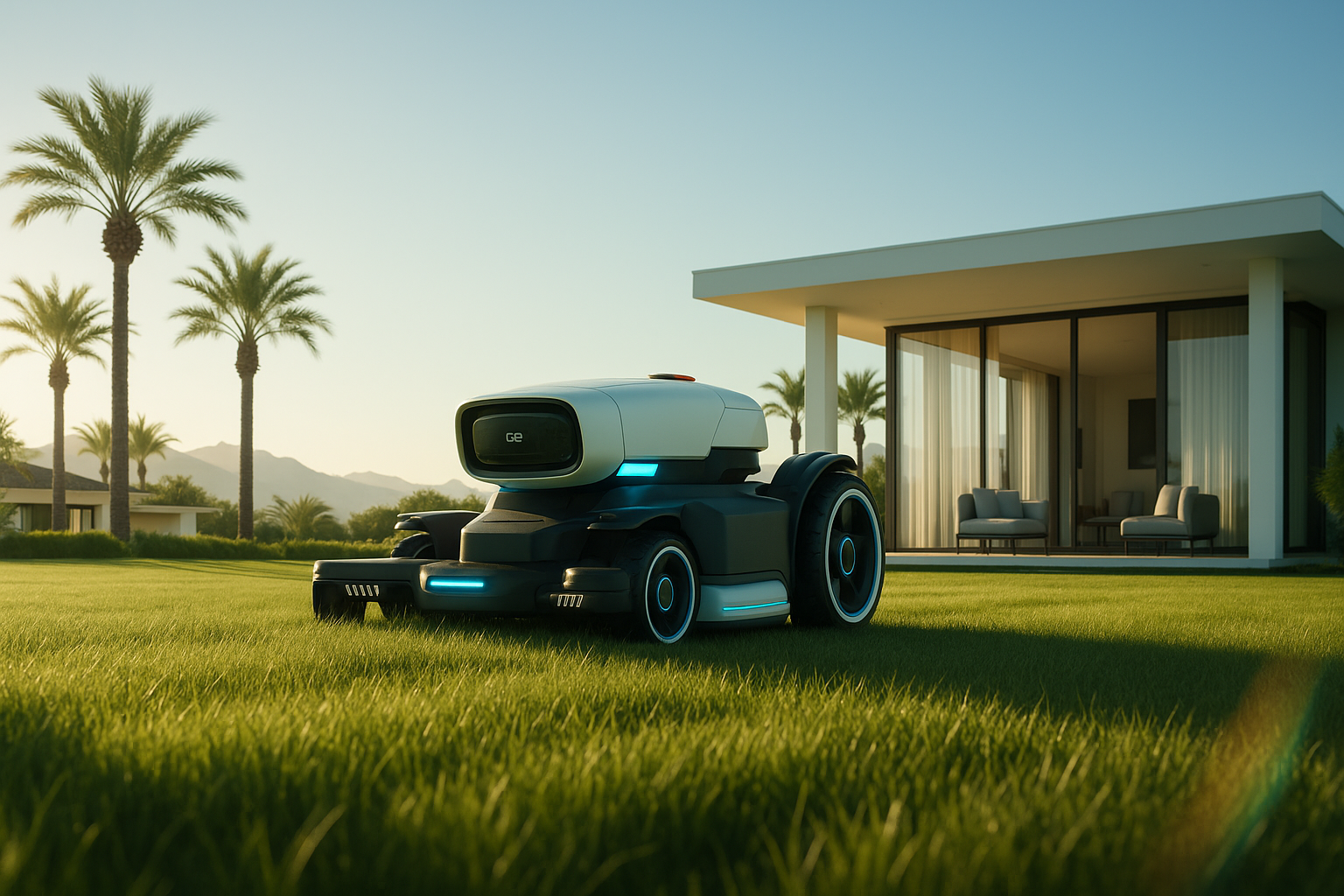The Rise of the Robot Lawn Mower
Tired of spending your weekends pushing a heavy lawnmower? Join the growing number of homeowners embracing the convenience of robot lawn mowers. These ingenious devices are revolutionizing lawn care, offering a hands-free way to maintain a perfectly manicured yard. This article provides a comprehensive guide to selecting the best robot lawn mower for your specific needs and budget, by comparing key features, performance metrics, and pricing across leading models. We’ll delve into how these machines work, explore different brands and their strengths, discuss essential features to consider, and help you navigate the costs associated with ownership.
Understanding Robot Lawn Mowers: How They Work
Robot lawn mowers are sophisticated machines that automate the process of lawn maintenance. Understanding their key components and functions is crucial for informed decision-making.
- Navigation Systems: Robot mowers use various methods to navigate your yard. Some rely on boundary wires, buried around the perimeter of your lawn to define the mowing area. Others use GPS for more precise navigation and mapping. Still others utilize sensors, such as bump and tilt sensors, to detect obstacles and edges.
- Lawn Mapping and Zoning: Many advanced models can create detailed maps of your lawn, allowing you to define zones with different mowing schedules or even create “no-go” areas, like around flower beds or patios. How accurate and reliable are lawn mapping features, and how easy are they to use? The accuracy can vary depending on the technology and the complexity of your lawn. Some systems offer seamless integration and intuitive interfaces, while others may require more calibration and technical expertise.
- Cutting Mechanisms: These mowers employ different blades and cutting systems. Some utilize small, razor-like blades that spin rapidly, mulching the grass clippings into fine particles that act as fertilizer. Others may discharge clippings, though mulching is the more common and beneficial approach.
- Power and Battery Life: Battery life is a critical factor determining the lawn size a robot mower can handle. Typical battery life ranges from 30 minutes to several hours. What is typical battery life, and how does it affect lawn size coverage? A longer battery life translates to the ability to mow larger areas on a single charge.
- Safety Features: Safety is paramount. Common features include lift sensors that stop the blades when the mower is lifted, tilt sensors that prevent operation on steep inclines, and obstacle avoidance systems that detect and navigate around objects like trees, toys, and pets.
Robot Lawn Mower Options: Models and Brands
The market offers a wide array of robot lawn mowers, each with its own strengths and weaknesses. Here’s a look at some leading brands and models:
- Husqvarna Automower: Known for GPS-assisted navigation, weather timers, and advanced security, Husqvarna Automowers are ideal for large lawns, complex landscapes, and tech-savvy homeowners. They generally also feature a quiet Noise Level (dB). What is the cost and performance of the latest Automower models? Expect to pay a premium for their advanced features, but you’ll get superior navigation and performance.
- Worx Landroid: Emphasizing AIA cutting technology, customizable features, and affordability, Worx Landroid mowers are well-suited for small to medium lawns, budget-conscious buyers, and DIY enthusiasts. They generally also feature a quiet Noise Level (dB). How reliable and efficient is the Landroid’s cutting pattern? Some users report occasional inefficiencies in complex lawn layouts, but the affordability makes it an attractive option.
- Robomow: With its edge cutting capabilities, robust design, and powerful motors, Robomow is designed for lawns with many edges and users who prioritize close-to-edge mowing. They generally also feature a quiet Noise Level (dB). How does Robomow handle uneven terrain and obstacles? Their robust design allows them to handle some uneven terrain, but complex obstacle courses may pose a challenge.
- Gardena: Focusing on silent operation, compact design, and integration with smart home systems, Gardena mowers cater to small gardens, noise-sensitive environments, and smart home integration fans. They generally also feature a quiet Noise Level (dB). What are the limitations of Gardena’s coverage area and cutting power? Their smaller size and less powerful motors limit their suitability for larger, more challenging lawns.
- Other Notable Brands:
- Segway Navimow: GPS-based navigation without boundary wires, designed for easy setup. (Example: Navimow H500E)
- Ambrogio: High-end models with sophisticated navigation and slope handling, suitable for complex terrains. (Example: Ambrogio L400i Deluxe)
- Yard Force: Focus on affordability and ease of use, ideal for smaller yards. (Example: Yard Force Compact 400Ri)
- How do these alternative brands compare in terms of price, performance, and reliability? Researching user reviews and professional comparisons is essential before choosing a specific model.
- Accessories: Some robot lawnmowers can be customized with a variety of accessories such as: replacement blades, off-road wheels, or charging stations
- Comparison Table: (This table should be populated with data after market research)BrandLawn Size CapacitySlope Handling (%)Navigation TypeBattery LifePrice RangeHusqvarnaUp to 1.25 AcresUp to 45%GPS, Boundary Wire50-70 mins$1500-$4000WorxUp to 1/4 AcreUp to 20%Boundary Wire60 mins$800-$1500RobomowUp to 1/2 AcreUp to 36%Boundary Wire60-90 mins$1200-$2500GardenaUp to 7500 sq ftUp to 25%Boundary Wire65 mins$900-$1800Segway NavimowUp to 0.5 AcresUp to 45%GPS, Vision90-120 mins$1400-$2800AmbrogioUp to 3.5 AcresUp to 75%GPS, ZCS150 mins$2500-$15000Yard ForceUp to 5000 sq ftUp to 30%Boundary Wire40 mins$500-$1000
Key Robot Lawn Mower Features to Consider
Choosing the right robot mower involves carefully evaluating your needs and matching them to the available features.
- Lawn Size Coverage: Measure your lawn accurately and choose a mower with sufficient capacity. Consider that battery life decreases over time. What happens if the mower’s capacity is exceeded? The mower may struggle to complete the job on a single charge, leading to uneven cutting and reduced efficiency.
- Slope Handling: Check the manufacturer’s specifications for the maximum slope the mower can manage. How does slope impact battery life and cutting performance? Steeper slopes require more power, reducing battery life and potentially affecting the quality of the cut.
- Smart Features and Connectivity: Many models offer smartphone app control, allowing you to schedule mowing times, adjust settings, and monitor the mower’s progress. Geofencing allows you to define virtual boundaries, and some models even integrate with voice assistants like Alexa or Google Assistant. Are smart features worth the extra cost? This depends on your level of tech-savviness and desire for remote control and advanced features.
- Obstacle Avoidance: Some mowers use bump sensors to detect obstacles, while others employ more sophisticated cameras and vision systems to navigate around objects intelligently. This is distinct from planned navigation using GPS or boundary wires. How effective is the obstacle avoidance in real-world conditions? The effectiveness varies depending on the complexity of the system and the type of obstacles.
- Security Features: Many robot mowers include anti-theft measures such as PIN codes to prevent unauthorized use, GPS tracking to locate the mower if stolen, and alarms to deter theft. Some can even be disabled remotely. How secure are robot mowers from theft? How often are robot lawn mowers successfully recovered after being stolen, and what role do security features play? While security features help, robot mowers are still vulnerable to theft. Recovery rates vary, but features like GPS tracking significantly increase the chances of finding a stolen mower.
- Rain Sensors: Rain sensors automatically stop the mower when rain is detected, preventing it from mowing wet grass. Does rain mowing impact the performance of the mower and the health of the lawn? Mowing wet grass can damage the lawn and clog the mower, so rain sensors are a valuable feature.
- Edge Cutting Performance: Some mowers have special edge-cutting modes or designs that allow them to trim closer to edges. How close to the edge can each mower cut, and are there any manual trimming requirements? The proximity to the edge varies, and some manual trimming may still be necessary, especially around intricate landscaping.
Robot Lawn Mower Prices and Budgeting
Understanding the costs associated with robot lawn mower ownership is crucial for making an informed decision.
- Price Range Overview: Robot lawn mowers range from around $500 for basic models to over $5000 for high-end models with advanced features. What factors contribute to price differences between models? Factors like lawn size capacity, navigation technology, smart features, and brand reputation all contribute to price variations.
- Budgeting Considerations: Don’t forget to budget for installation (if you choose professional installation), accessories like extra boundary wire or replacement blades, and ongoing maintenance costs. What are the long-term costs of owning a robot lawn mower? Long-term costs include blade replacements, battery replacements (every few years), and potential repairs.
- Financing Options: Some retailers offer financing plans or payment options to make robot lawn mowers more accessible. Are there any government rebates or incentives available for purchasing robot lawn mowers? Check with your local government or utility company to see if any rebates or incentives are available for purchasing energy-efficient lawn care equipment.
- Value vs. Cost: Consider the trade-offs between price and features. A more expensive model may offer superior performance and convenience, but a more affordable model may suffice for smaller, simpler lawns. Is it better to invest in a higher-end model or a more affordable one? The best choice depends on your specific needs, budget, and tolerance for manual adjustments.
- Energy Consumption: Consider the electricity costs associated with charging the mower. How does the energy consumption of different models compare, and what is the environmental impact of this energy use? Check the energy consumption ratings of different models to compare their environmental impact.
Installation and Maintenance
Proper installation and maintenance are essential for ensuring optimal performance and longevity of your robot lawn mower.
- DIY vs. Professional Installation: DIY installation typically involves laying the boundary wire, setting up the charging station, and configuring the mower’s settings. Professional installation ensures proper setup and calibration. What are the pros and cons of each approach? DIY installation saves money, but professional installation provides peace of mind and ensures optimal performance.
- Boundary Wire Setup: The boundary wire defines the mowing area. It can be buried underground or secured to the surface with stakes. What are the common challenges and solutions for boundary wire installation? Common challenges include navigating corners, avoiding obstacles, and ensuring proper wire tension. Refer to the manufacturer’s instructions for best practices.
- Regular Maintenance Tasks: Regular maintenance includes cleaning the mower, replacing the blades, and caring for the battery. How often should maintenance be performed? Consult the manufacturer’s guidelines for recommended maintenance schedules.
- Installation and Maintenance Accessories: refers to items like wire connectors, blade replacement tools, and cleaning brushes.
- Troubleshooting Common Issues:
- Mower stops with ‘Out of Bounds’ error: Check boundary wire integrity, adjust sensitivity settings.
- Uneven cutting: Check blade sharpness and cutting height settings.
- Mower gets stuck: Clear obstacles and adjust mowing schedules.
- Regular cleaning, blade replacement, and battery care are crucial for maintaining optimal performance.
Environmental Impact of Robot Lawn Mowers
Robot lawn mowers offer several environmental benefits compared to traditional gas-powered mowers.
- Noise Pollution: Robot mowers are significantly quieter than gas-powered mowers, reducing noise pollution. How quiet are the quietest robot mowers? Some models operate at noise levels as low as 60 decibels, which is comparable to a normal conversation.
- Emissions: Robot mowers produce zero emissions during operation, contributing to cleaner air. What is the carbon footprint of manufacturing and operating a robot lawn mower? While the manufacturing process does have a carbon footprint, the overall emissions are significantly lower compared to gas-powered mowers.
- Impact on Wildlife: There are concerns about the impact on small animals and insects. Are there any specific safety measures available to reduce the environmental impact? Operating the mower during daylight hours, when wildlife is less active, can minimize potential harm.
Making the Right Choice: A Buyer’s Guide
Choosing the best robot lawn mower requires careful consideration and planning.
- Assess Your Lawn: Size, shape, obstacles, slope.
- Prioritize Features: Identify must-have features based on your needs.
- Set a Budget: Determine how much you’re willing to spend.
- Read Reviews: Research online reviews and expert opinions.
- Consider Long-Term Costs: Account for maintenance and repairs.
- Assess your tolerance for maintenance: Are you OK with a low maintenance mower that occasionally needs its blades cleaned, or do you need a maintenance free model
- Assess your risk tolerance: Some models are more prone to theft. Are you okay with purchasing an expensive model that could be taken from you?
- Final Decision: Choose the best robot lawn mower for your situation.
The Future of Lawn Care?
Robot lawn mowers are transforming lawn care, offering a convenient, eco-friendly, and time-saving solution for maintaining a beautiful yard. By understanding the key features, considering your specific needs, and carefully comparing different models, you can choose the perfect robot mower to simplify your life and enjoy a perfectly manicured lawn without lifting a finger.
Future advancements may include even more sophisticated navigation systems, improved obstacle avoidance capabilities, and enhanced smart home integration. Embrace the future of lawn care and reclaim your weekends!







Leave a Reply